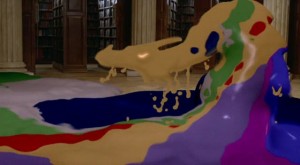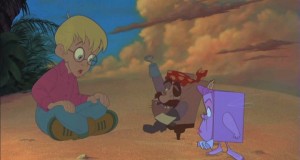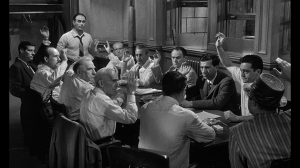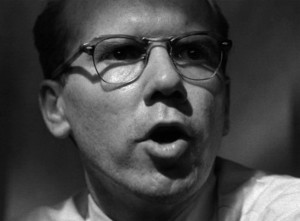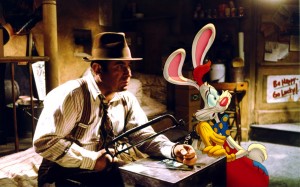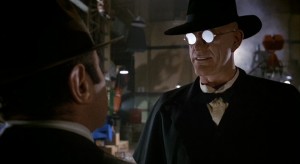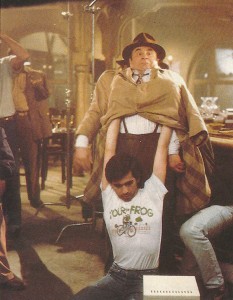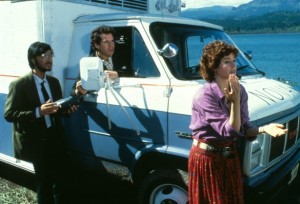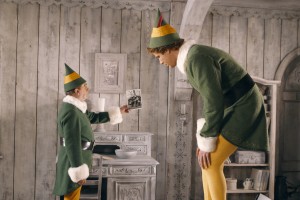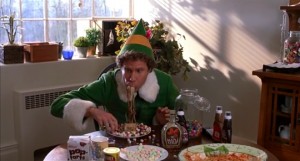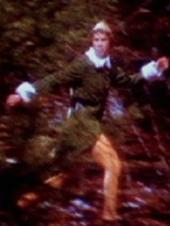I originally intended to officially end this Countdown with a post-#1 debriefing of sorts, but as it turned out, the conclusion of the UHF entry ended up serving well as the list’s final word.
However, since I teased the possibility of an “honorable mentions” post several times throughout the Countdown, I thought I should EVENTUALLY follow through and deliver a real, final, ultimate end to the “100 Film Favorites.” At least, until, you know, I see another movie I like and everything changes.
So without further ado, here are 11 mercifully short micro-reviews of great films which just barely missed out on Countdown entries of their own (the top five or so really should have been included, and probably would be if I were to revamp the list).
11. The Pagemaster
(Joe Johnston, Pixote Hunt, & Glenn Chaika, 1994)
Macaulay Culkin stars as Richard Tyler, a paranoid boy who spends his life obsessively reading and memorizing statistics relating to disasters. As such, he is afraid of virtually everything, and refuses to leave the relative safety of his room. One night while riding his bike home from a hardware store (Richard’s father is building a “highly dangerous” treehouse and sent him to buy nails), Richard is forced by a sudden storm to seek refuge in a library. There, he meets the mysterious librarian Mr. Dewey (Christopher Lloyd), who confides that the solutions to many of life’s problems can be found if one “looks to the books.” Richard mostly ignores the bon mot and attempts to leave, but slips halfway across the library and smacks his head on the marble floor. When he “comes to,” Richard notices the painting on the ceiling above – a great tableaux featuring many of literature’s most famous characters – is dripping. This “melting” accelerates until the painting has morphed into a massive CGI paint-dragon, which pounces on Richard.
Richard now finds himself animated, or “an illustration,” as the Pagemaster puts it. The Pagemaster (also voiced by Christopher Lloyd), a vaguely-defined, library-themed wizard, explains that Richard must journey through the realms of Horror, Adventure, and Fantasy before he can return to his own world. The rest of the movie proceeds Wizard of Oz style: Richard acquires three companions on his journey (talking-book embodiments of the horrror, adventure, and fantasy genres). He faces many obstacles along the way (literary foes including Jekyll & Hyde, Long John Silver, Captain Ahab, and a fire-breathing dragon). Finally, he reaches the end of his quest, only to “awaken” in the same place he collapsed on the library floor. But whether or not it was all a dream, Richard has learned courage through his adventures, and climbs into the now-completed treehouse with a stack of new books.
Pros:
- Great voice cast, including a bevy of Star Trek alumni, from Patrick Stewart and Whoopi Goldberg to Mr. Spock himself, Leonard Nimoy.
- Pretty impressive animation. One of the first films to combine live-action, traditional animation, and CGI.
- As a bookish child already, I appreciated the many literary references. Nimoy is seriously scary in the dual role of Jekyll & Hyde.
Cons:
- The famous literary characters are given ludicrously short shrift. No sooner are they introduced than they’re cast aside for another character’s introduction. Thus, none of these legendary characters gets any sort of development, and you’re left feeling cheated.
- The film’s moral is dubious: Richard technically already spent his life “looking to the books” – he was literally obsessed with reading, spending nearly all his time indoors. He doesn’t need to learn the wonders of books, he needs to learn the wonders of going outside! Which he admittedly does at the end of the film…only to go and read more books.
10. 12 Angry Men
Probably the best feature-length film ever to take place in a single room, 12 Angry Men follows the deliberations of a jury tasked with determining the fate of a young man accused of murder. Initially, 11 of the 12 vote “guilty,” but protagonist Henry Fonda gradually encourages his fellow jurors to further consider the evidence, the witnesses’ testimony, and their own personal prejudices. After protracted debate which occasionally escalates into full-blown blood-and-thunder rage, Fonda is able to convince all of his fellow jurors that there is “reasonable doubt” regarding the accused’s guilt, and the twelve vote to acquit. Despite the apparent intimacy of the impassioned exchanges we’ve seen, only as they rise to leave the jury room do a few of the jurors actually learn each other’s names, before disappearing back into the crowd outside and returning to their own lives.
Pros:
- Features an excellent cast, with many well-known faces of the day (especially if you’re a die-hard Twilight Zone fan as I am). Jack Klugman of The Odd Couple and John Fiedler (Disney’s original Piglet) are two of the most recognizable.
- Offers a dramatic glimpse into the workings of the American trial-by-jury justice system. One of the all-time great works of fiction in the “Courtroom Drama” genre.
Cons:
- JURIES SHOULD NOT WORK THIS WAY. The jurors of the film engage in rampant speculation regarding presented testimony, and Henry Fonda even goes so far as to introduce his own evidence to sway the others in favor of acquittal. As such, the men create “reasonable doubt” where there was none before. Supreme Court Justice Sotomayor says she has cautioned real jurors to consider facts as presented and not emulate the movie’s characters.
9. Who Framed Roger Rabbit?
What happens when Disney teams up with Steven Spielberg? You get a staggeringly unique film which renewed popular interest in the “Golden Age of Animation” and may have been the first spark of the much-lauded “Disney Renaissance” of the 90s. Who Framed Roger Rabbit is a live-action/animation hybrid, and though similar techniques were used in earlier Disney productions like Mary Poppins and Bedknobs and Broomsticks, the artisans behind this film brought the “fusion” medium to a whole new level of craftsmanship.
The film’s noir narrative is set in an alternate 1940s Los Angeles in which cartoon characters, or “toons,” dwell alongside human beings and make a living acting out animated films in the same way that their human counterparts act out “live-action.” When Roger Rabbit, Toontown’s biggest star (something of a combo between Bugs Bunny and Mickey Mouse) suddenly finds himself framed for the murder of cartoon gag tycoon Marvin Acme, he seeks out the counsel of Eddie Valiant, an embittered private eye who was once a friend of the toon community, until the day his brother was the victim of a fatal piano-dropping at the hands of a wild-eyed toon. As the intricate mystery unfolds (to their credit, the filmmakers didn’t dumb-down the plot one iota for the ostensible family audience), Eddie and Roger not only discover the identity of Acme’s real killer, but also a plot to destroy the public transit train system in favor of building more motorways (a real-life conspiracy among car manufacturers of the era), and to erase Toontown from the map.
Highlights:
- It’s hard to oversell just how visually impressive this film really is. Throughout, live actors blend seamlessly with, and truly seem to “interact” with, a bevy of animated characters. As I mentioned while discussing the knights-vs.-nazis battle in Bedknobs & Broomsticks, Roger is so stunning because the central effect “works.” George Lucas’ Industrial Light and Magic team worked in tandem with the animators to composite-print multiple light and texture effect layers over the “toon” characters, making them really seem to inhabit the same physical space as their human co-stars. But, as with Bedknobs’ ghost armor or Jurassic Park‘s dinosaurs, the true excellence of the Roger Rabbit effects results from a variety of effects technologies working in harmony. The animators certainly demonstrated skill in incorporating the “toons” into the movie’s many effects-heavy shots, but the live actors perhaps showed even more talent in performing their roles in the first place (the leads all took mime classes to better interact with their invisible “colleagues”). To take the effect to even more unbelievable heights of “reality,” the toons actually MANIPULATE LIVE-ACTION OBJECTS, including plates, pianos, and handguns. To accomplish these shots, the filmmakers constructed specialized robots to “act” the required roles. These devices would then be animated over with the “real” character later. Seriously, just watch this making-of documentary . These were craftspeople whose skill has perhaps never been equaled since. Remember, this was all “traditional,” HAND-DRAWN animation. Even if a project as ambitious as Roger Rabbit is ever tried again, moviemakers doubtlessly will be aided by computers, a luxury still unknown in 1988.
- Finally, it’s great fun to see so many classic cartoon characters appear together on-screen. Way back before Toy Story and Wreck-It Ralph, many studios lent their iconic characters to the project. In order to avoid allegations of bias on the part of Disney, Bugs Bunny appears in the film for exactly as long as Mickey Mouse does. Donald and Daffy Duck likewise share equal screentime.
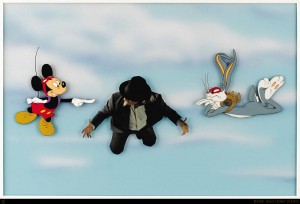 Tidbit: Charles Fleischer, who voices Roger Rabbit (as well as his car, Benny the Cab), insisted on wearing an actual Roger Rabbit costume on set, to enhance the “reality” of his performance, speaking and acting out his lines off-camera.
Tidbit: Charles Fleischer, who voices Roger Rabbit (as well as his car, Benny the Cab), insisted on wearing an actual Roger Rabbit costume on set, to enhance the “reality” of his performance, speaking and acting out his lines off-camera.
8. Short Circuit
(John Badham, 1986)
In the initial draft of my Countdown, this one was penciled in at #65. But before I wrote that post, I re-watched the film, and found I didn’t enjoy it nearly as much as I remembered. You’ll find a mention of my dilemma in the post which eventually replaced it, We’re Back!.
There isn’t a whole lot to say about this one. It follows a robot simply named Number 5, who is struck by lightning one day and “brought to life,” after which he gradually gains sentience. In a stupor, the “newborn” robot wanders off the military base where he was built. After stowing away on a truck and bailing out atop the Astoria Bridge (like The Goonies, this is another popular 1986 film set in Astoria, Oregon; Perhaps they were offering tax-breaks at the time), Number 5 arrives at the home of Stephanie, a liberal young woman who mistakes him for an extraterrestrial. Stephanie eagerly provides her “alien” visitor with “input,” as he is desperate to learn about the world and his new situation in it. As he blazes through the Encyclopedia and expands his vocabulary, Number 5 begins to form a friendship with Stephanie.
Stephanie feels betrayed when she discovers Number 5’s initial directive: to serve as the army’s latest super-weapon. But then the two realize that said army is hot on their trail, intent on reclaiming their multi-million dollar “war machine.” Earlier in the film, Number 5 had inadvertently squashed an insect, only to find that Stephanie is incapable of “reassembling” a living thing. Now, Number 5 fears the army will disassemble him due to his “flaw,” essentially killing him. He begs Stephanie for her help, and she overcomes her reservations and agrees.
Soon, the travelers are joined by Number 5’s programmers, who have also been pursuing him throughout the movie. The programmers, Newton (Steve Guttenberg) and Ben (an Indian character totally played by a white guy in brown-face) have long held that their robot creation has potential for peaceful and artistic uses beyond the military’s hostile intent. They agree to help Stephanie, though they at first respond incredulously to Number 5’s claims of sentience. As the traveling trio and their robot refugee continue their journey, however, it becomes more and more clear that, just as the tagline says, “Number 5 is alive.” In the end, they give the military the slip (Number 5 constructs a non-sentient duplicate of himself which the army destroys instead), and Stephanie and Newton, now a couple, escape into the wilderness with the robot, who christens himself “Johnny Five.”
Short Circuit is without a doubt one of the best “robot movies” out there. Perhaps that’s not saying much. But the intricate animatronic effects used to bring Number 5 to life still look impressive, and the character’s legacy can still be felt: Just look at Wall-E’s head and tell me they weren’t copying. Additionally, the filmmakers’ goal to portray human characters as skeptical toward robots’ claims of sentience is an interesting change in a genre where robotic beings (like the droids in Star Wars) are often portrayed almost as equals to their organic counterparts.
Tidbits: Two years later, Short CIrcuit 2 was released. Though Ben is the only human character to return from the original movie (Steve Guttenberg and Ally Sheedy went on to make more money), the sequel just might be a better film. It’s certainly more emotionally intense. Johnny’s drawn out “death” sequence is just as heart-wrenching as the memory-loss scene at the end of Wall-E. Only, like, you know, ten times worse.
7. Dr. Strangelove or: How I Learned to Stop Worrying and Love the Bomb
(Stanley Kubrick, 1964)
Let me start off by saying that this film deserves, and has received, far more ink than I’ll give it here. It remains an undisputed classic of cinema and ranks among the most poignant pieces of 20th century political satire ever produced. It frankly has no right to be shoehorned into a few-paragraph aside in a small-time blogger’s “honorable mentions” post.
And yet, here we are.
Dr. Strangelove is a black comedy (“code,” as my friend Elliot would say, “for not actually being funny”) which chronicles the governmental scramble on both sides of the Cold War to set things right after an American general “goes rogue” and orders a nuclear assault on the Soviet Union. In the opening moments of the film, Air Force General Jack Ripper (yes, that’s really his name), a conspiracy theorist who fears that Communist-ordered water fluoridation has “corrupted his bodily fluids” and diminished his sexual stamina, commands his fleet of bombers to head for their targets inside Russia and drop their nuclear payloads. The code associated with the order mandates a change in the planes’ communications protocol: their attack mission can only be called off with a three-letter code…which, unfortunately, only General Ripper knows.
Peter Sellers, last seen in my entry on Hal Ashby’s Being There, stars in a triple role: First, he’s Captain Lionel Mandrake, a British RAF officer and Ripper’s ostensible second-in-command, who frantically tries to convince the addled General to call off the nuclear strike. He’s also American President Merkin Muffley, who now must call the Soviet Premier and inform him that Ripper has “gone a little cuckoo” and “done something silly.” Finally, he’s the titular Dr. Strangelove, an ex-Nazi scientist recruited to aid the American military (a la Wernher von Braun and others recruited after WWII via Operation Paperclip). As deliberation continues, Strangelove totters around the room in his wheelchair, concocting several strategies for survival should worst come to worst.
The minutes tick away as President Muffley, Dr. Strangelove, and other high-ranking personnel hunker in a bunker (the stark, expressionistic “War Room” set remains one of the most iconic images of Cold War-era pop culture) and attempt to reason out their next move, “playing poker for the fate of the world.” Muffley’s most vocal adviser is Army General Buck Turgidson (played to the hilt by George C. Scott). At first, Turgidson suggests letting the attack proceed, citing calculations that suggest a full-out American assault could cripple 90% of the Soviet nuclear program, resulting in U.S. casualties of “only 10 or 20 million…tops.” But the stakes rise far higher when the Soviet ambassador arrives and reveals the existence of a Soviet “Doomsday Device” capable of eradicating all life on Earth. The Device, a network of interconnected cobalt bombs buried throughout Soviet-controlled territory worldwide, is set to detonate when triggered by an incoming nuclear blast. Once triggered, there is no way to disarm it.
As the film progresses in very-nearly-real time, the President, the Premier, and the advisers continue hashing out ways to avoid an atomic apocalypse. Eventually, Captain Mandrake manages to deduce the call-off code, and the Air Force successfully re-directs all bombers not yet shot down by the Soviet military. All, that is, except for a single intrepid plane with a damaged radio system which soldiers on undaunted. When pressed, General Turgidson proudly asserts that even a “great big plane” such as a B-52 could “come barrelin’ in” under Soviet Radar if piloted skillfully. Though he proclaims this with wide-armed gusto, Turgidson’s joy quickly fades as the grim implications of the possibility set in.
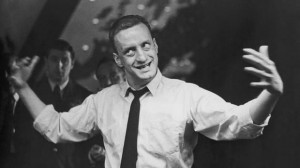 And all the while, the crew of the single remaining B-52, motivated by patriotism and the millions of Americans supposedly urging them on, grow closer and closer to their target inside Russia…
And all the while, the crew of the single remaining B-52, motivated by patriotism and the millions of Americans supposedly urging them on, grow closer and closer to their target inside Russia…
What humor there is in Dr. Strangelove derives mostly from exposing the lunacy of Mutually Assured Destruction, and the fact that petty rivalries endure even in the face of ever-approaching Armageddon. In the film’s final moments, Dr. Strangelove proposes that, even if the Doomsday Device detonates, a population of several hundred thousand hale and hearty Americans could endure in impromptu shelter communities at the bottom of deep mine-shafts. Both Turgidson and the Soviet ambassador are intrigued by the idea that a ratio of ten extremely “stimulating” women to every man would be necessary to ensure timely re-population. Pulling themselves away from their mutual lascivious imaginings, the two men are instantly suspicious of one another again, each afraid that the other’s country will be the first to construct a superior mine-shaft, creating a “mine-shaft gap” which will provide an advantage when the two decimated nations re-emerge after a century of fallout hell.
And then the world ends.
- Tidbits: Peter Sellers was originally set to portray a fourth role: Major “King” Kong, the bomb-riding gentleman in that last clip. Sellers was convinced he could not do the character’s Texan accent justice, and so cowboy character actor Slim Pickens was brought in to play the part. To emphasize the “reality” and serious tone of the scenes inside the B-52, Pickens received script pages for only his scenes, and was not told the film was a comedy.
- The first ending filmed for the movie had tensions rising until a fight broke out between the American and Soviet personnel…a pie-fight. Cream pies can still be seen in the background of the final scenes, but the sequence was cut for being too farcical and dulling the film’s satirical tone.
- Kubrick’s characters have names which would put Dickens to shame. In addition to such outlandish monikers as Jack Ripper and “Bat” Guano, several are blatantly sexual. “Merkin” and “Muff”ley are both references to pubic hair. General Turgidson’s name incorporates the word “turgid,” an adjective meaning “swollen rigid with fluid,” or erect.
- On that note, phallic symbolism is rampant, from Ripper’s first chomped cigar to Major Kong straddling a missile and riding it to oblivion.
- Peter Cecil Bull, a British character actor, portrayed the Soviet ambassador. Three years later, he would play General Bellowes in Doctor Dolittle.
6. Elf
(Jon Favreau, 2003)
Now we’re getting into films which really should have earned a slot in the official Countdown, but missed out either because they slipped my mind at the time or due to other mitigating factors.
Clocking in at #6 is the movie which proved Will Ferrell could do sweet, “family” comedy every bit as well as more adult fare. I excluded Elf from the Countdown primarily because I felt I’d already worked in too many Christmas-themed entries. That was an oversight. The 2003 film stands as a modern yuletide classic, and perhaps the greatest Christmas comedy of the last twenty years (with the possible exception of the first Santa Clause).
Elf tells the tall tale of Buddy (Ferrell), a human who snuck into Santa’s sack as a baby and stowed away on the return trip to the North Pole. Wise old Papa Elf, our narrator (Bob Newhart), recounts how he adopted and raised Buddy as he would an elf child. This grew more difficult, however, as Buddy himself outgrew the elf world around him (through the use of many of the same forced-perspective effects seen in Darby O’Gill, Ferrell humorously dwarfs everything from his bed, to his toilet, to his coworker elves. Buddy also feels ostracized due to his inferior toy-making skills compared to the innate abilities of real elves (he makes 85 Etch-a-Sketches in a day, against a quota of one thousand). Eventually, Papa Elf has no choice but to tell Buddy the true story of his origins: Buddy’s father, Walter Hobbs (James Caan), is a high-ranking publisher in New York City, and his mother, Hobbs’ college sweetheart, put baby “Buddy” up for adoption without ever revealing his birth to his father.
And with that, Buddy sets out for the human world to meet his father and catch up on 30-some Christmases and a “real” childhood. But he comes with his “elf culture” in tow, including a penchant for woodworking and a diet consisting of “the four main food groups: candy, candy canes, candy corns, and syrup.”
I love so much about this movie. It’s funny all the way through. James Caan’s uptight, deadpan responses to Will Ferrell’s zany antics and cloying sweetness never fail to make me laugh. Additional humor derives from Buddy’s naivete in the big city: he eats used gum found beneath park railings, takes as gospel a cafe’s claim to the “world’s best cup of coffee,” and learns the hard way that, when it comes to cars, “the yellow ones” (taxis) “don’t stop.” Then there are a handful of gags which come almost out of nowhere: In a doctor’s office, Buddy sneakily gobbles cotton balls like cotton candy; footage of him crossing Central Park late in the film resembles the iconic “Patterson footage” of bigfoot.
In among the laughs, you’ll also find a great soundtrack, animated tributes to the classic Rankin-Bass Christmas specials of the 60s, and a heartwarming story in which Buddy successfully “finds his place,” finds love (with Zooey Deschanel in one of her first major roles), and spreads Christmas cheer to his cynical dad, his new family, and the city of New York beyond. Though it missed out on the official Countdown, Elf makes my must-watch list every December.
Tidbit: As with most of his films, Jon Favreau makes a cameo. He appears as the doctor who confirms Walter’s paternity of Buddy (and whose cotton balls Buddy surreptitiously snacks on).



